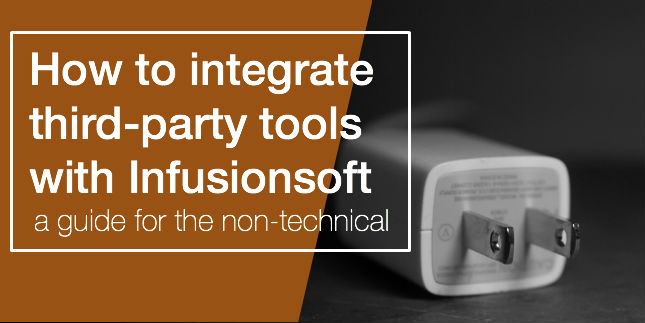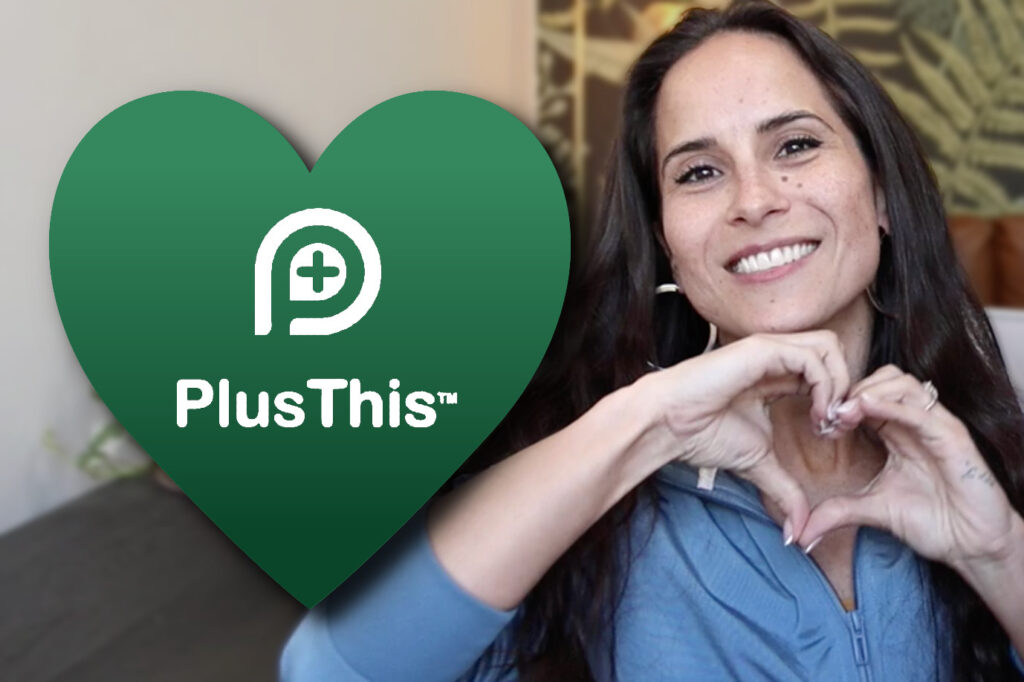I’ve been in the Infusionsoft Eco-system for almost 10 years now. In that time Infusionsoft has gotten easier to use, and the community of marketing automation experts that specialize in Infusionsoft has grown dramatically.
It’s never been easier to find someone with the expertise to help you implement your marketing strategies into solid campaigns.
But the process of integrating Infusionsoft with other platforms still flabbergasts all but the most technical in the Infusionsoft community.
For the rest of us, we usually end up searching for help and this is how the conversation goes:
You: “I love Infusionsoft, but I wish it would do ~What-I-Wish-Infusionsoft-Could-Do~.”
Infusionsoft Expert (or Plugin Sales Rep): “Infusionsoft can’t do that out of the box, but with ~Really.CoolPlugin~ you can make it happen.”
You: “Great, so I just buy it and then I’m good to go”
Expert: “No, you have to ~Super-Techie-Explanation-That-Doesn’t-Sound-Worth-The-Effort~”
You: ~Favorite.Expletive~
At this point one of three things happens:
- You give up… let’s face it, this is going to take way more effort than you have time to give.
- You dive in (because you have the can-do attitude and amazing work ethic). You end up spending way more time trying to figure out how to make it work, eventually giving up, or figuring it out (at least to the point that the stupid thing kind of works, and you can move to revenue producing actives).
- You hire an expert to do it for you (which is a great option if you have the budget).
But what if you don’t have the budget to pay an expert to do it for you? Or what if you are just the type of person that wants to understand how everything works? If so, this guide was written for you.
Understanding Plugins
If you want to learn all the terminology and intricate details of integrations, this isn’t the article for you. I’m going to keep this simple, but there are a few details you MUST understand before you get started with any plugin.
- To start off, you need to understand that plugins (sometimes called integrations or connectors) allow Infusionsoft to “communicate” with another solution or tool so each can do more for you. They usually pass information either from one to the other, or, back and forth.
2. There is a difference between direct integrations and 3rd party integrations.
Some tools integrate directly with Infusionsoft. To use an analogy, when you have a direct integration it’s like Infusionsoft and the other tool can speak the same language, so they don’t need to hire an interpreter to talk to each other.
But sometimes a third party is required to integrate Infusionsoft with another app or tool. Keeping with the analogy, let’s say Infusionsoft speaks English, and the other tool you are trying to integrate with speaks Spanish… and neither one wants to learn the other language to make life easier for you as the end user. When that is the case, a 3rd party integration comes to the rescue and acts as an interpreter so the two can work together and you get what you need from both tools.
Shout out to Jordan Hatch for the analogy assist.
3. You will need to give the two tools permission to talk to each other. This is a good thing, otherwise any tool could integrate with your Infusionsoft account and wreak all sorts of havoc.
If you are working with a direct integration you typically only have to authorize that tool to talk to your Infusionsoft app.
If you are working with a 3rd party integration you will need to authorize the 3rd party tool (remember this is the interpreter) to talk to your Infusionsoft app AND the other tool you want to integrate with Infusionsoft.
4. There are generally two ways to grant permission
- The first is call OAuth. Don’t worry about the term, this just means to grant permission by entering your username and password for Infusionsoft (and/or the other tool if they are set up with OAuth as well), and then click a button that says that you give the integration permission. It’s that easy. You’ve probably done this many times (like when you used your Facebook account to login to your Candy Crush or Clash of Clans account).
- The second is by providing your API key and app name. This is the ‘old’ way of integrating. It is a little less secure, but still does the trick. If your integration is asking for your app name and api key you can follow these steps.
5. You need to understand how the integration will communicate with Infusionsoft.
Most of the time you will be working with integrations that tie into the campaign builder. If that’s the case, there are typically two goals that your integration will use to trigger automation to start or stop, and one way for Infusionsoft to trigger your other application to do its thing.
Normally integrations trigger automation in Infusionsoft by either achieving a campaign API goal or applying a tag.
API goals are one of the scarier goals to work with initially because most of us don’t write code, or completely understand what is happening in the background. When you go to configure an API goal it asks you for your “Integration” and “Call Name”. You don’t need to worry about the specific terminology here. Your integration is essentially sending a signal to Infusionsoft with these two key pieces of Information and Infusionsoft is watching for those to know which campaigns need to be triggered.
All you need to do is ensure that the “Integration” and “Call Name” you set up in the tool you are integrating match the “Integration” and “Call Name” you configure in your campaign.
The majority of integrations with Infusionsoft work by applying tags. Back when Infusionsoft’s campaign builder was released tags were really the only way to trigger automation to start and stop from an integrated tool. And thus, tags became the Infusionsoft API developer’s go to tool.
For this, and a handful of other reasons, tags cause more confusion than they should.
Tags were originally designed to segment your database into lists, and to be able to slice your lists any way you could dream of, but when developers started using tags out of necessity to trigger campaign automation, things got a little messy, but with a good tag naming convention you can overcome this confusion and make tags work for you.
(If you don’t have a tagging system yet, check out this list of options Greg put together.)
One gotcha you need to account for when using tags to start or stop campaign sequences is that a tag cannot be applied to a contact who already has that tag.
So, if you ever need to achieve the same goal multiple times you will need to remove the tag before reapplying it. This can be done automatically in campaign sequences, but you’ve gotta plan for this scenario if you don’t want to bang your head against the wall while you try to figure out why the integration isn’t working the way you were expecting it to.
In my opinion, completing an API goal is the cleanest way to trigger automation from an Infusionsoft integration. Unlike tags, API goals can be achieved multiple times without issue.
Whenever I have the option between these two, I go with the API goal completion.
The way Infusionsoft can trigger things to happen in your plugin tools (such as sending an SMS, or triggering a batch of delicious cookies to be sent to the contact) is by sending an HTTP post to a dedicated URL that will be provided by your integration provider. Typically, the tool you are working with will provide you with detailed instructions on how to set up these HTTP posts.
6. Have a strategy.
This isn’t an exhaustive list of everything you need to know to integrate every tool out there with Infusionsoft; that would take years to compile. But this is a list of the basics you need to know when integrating another tool with Infusionsoft.
But knowing how to tie two systems together and having a strategy to effectively use multiple tools in your marketing automation efforts are two different things. If you don’t have a well planned out strategy you will end up frustrated and disappointed.
So, once you understand what it’s going to take to integrate a tool with Infusionsoft, take the time to create a solid strategy that will help you get results and not just a new shiny object in your automation toolkit.
If you are a DIY type of person and you need help coming up with a strategy, the Monkeypod Grove FB group is a great place to start (you should join if you haven’t already).
If integrating another tool still intimidates you, you may also consider reaching out to a well-qualified expert to help you design and implement your Infusionsoft integration set up.
Editor’s note: Justin is a long time friend of mine, and established expert in the Infusionsoft ecosystem, if you’d like to learn more about working with him or his team you can check them out at Bandera Marketing.






This is awesome! Super excited to start diving into this a little more once I get my support up and running on daily operations. 🙂
Thanks Bandera.
Yesssss! Thanks for reading Laura. 🙂
Thanks Laura Frances. The great thing abouy Infusionsoft is that it has become a platform that you build upon. When Infusionsoft can’t there is usually a plugin that can.
I’m definitely looking into this too!!
We use Zapier for a few “small” things (yet save so many repetitive procedures!!).
Zapier is one of my favorite tools. It lets you integrate almost anything to make life a little easier.